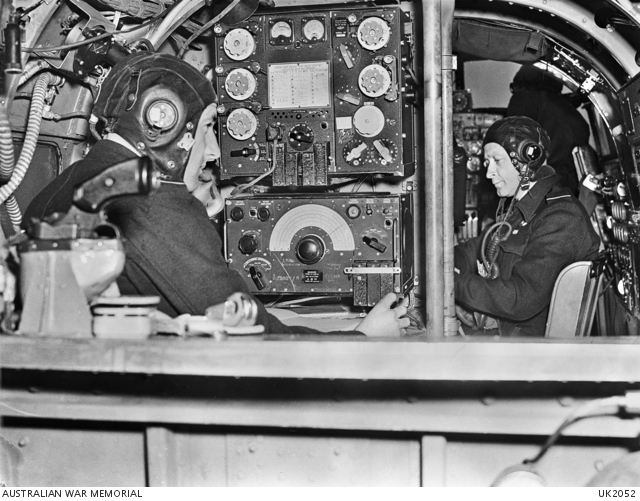Striking by Night - Wireless Operator (WOP)
Crew
Personal particulars
Height - 5 ft 2in min and no taller than 6 ft
Weight - not over 175lbs
Physical position in plane

Location of wireless operator
He sat behind and faced the the navigator station, facing him. Had a table and light.
Equipment
According to the Kings’ Regulations, which governed Air Force law, a multi–engined aircraft was not permitted to take off without a wireless operator.
The standard wireless was the T1154/R1155 “Marconi” or “Rainbow set” named for the yellow, blue and red knobs. It had both voice and Morse capabilities. Voice was rarely used.
The batteries were stored underneath all this. A code book was updated and carried on each flight. WOP had a bag of spare valves, pliers and a screwdriver. Behind his seat was a Verey signal flare pistol for use, by the navigator, if the plane crashed in friendly territory.
Responsibilities
He was the crews’ link with base.
- Taking bearings and fixed position reports from ground transmitters, using a direction finding (DF) loop behind the cockpit. He had to turn this until he got a steady Morse code identification coming through.
- Mostly the plane was on radio silence
- Half hour wind readings were sent to base
- Transmissions were made in an emergency
- Kept a log of all messages received
- In some planes, it was also WOP’s job to “drop window”
- Adjust the planes heating outlet which was situated just next to him. However, when he was comfortable it usually meant the rest of the crew were cold! It was often down to -40 degrees!
- From early 1943, WOP’s also jammed German fighter control transmissions
Dress
A typical uniform consisted of a helmet, oxygen mask, parachute, boots, shirt, trousers, tie, gloves, a whistle and an escape kit.
Wireless operator Flying Officer C. H. Tindale DFM, of Cremorne, NSW (left), tuning while the navigator, Flying Officer W. C. Gordon DFC, of Raleigh, NSW, studies his charts just before take off in the Lancaster "G for George".
